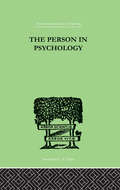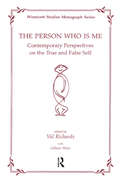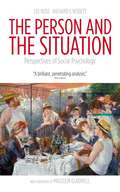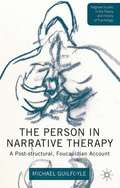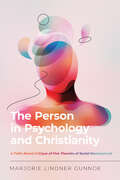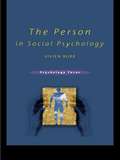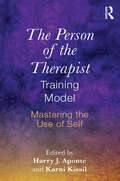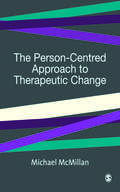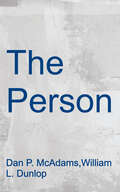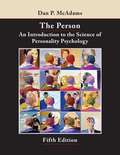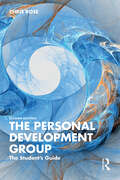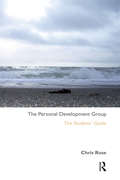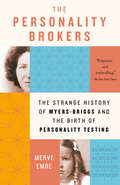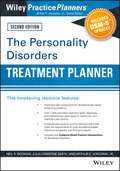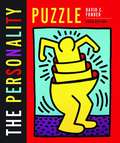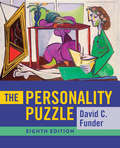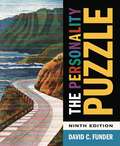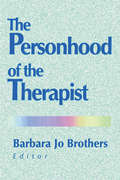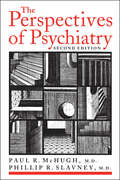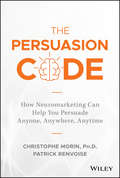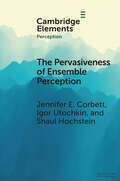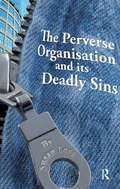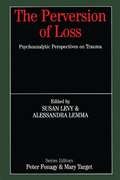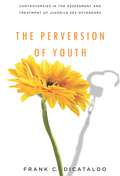- Table View
- List View
The Person In Psychology: REALITY OR ABSTRACTION (International Library Of Psychology)
by Lafitte, PaulFirst Published in 1999. Routledge is an imprint of Taylor & Francis, an informa company.
The Person Who Is Me: Contemporary Perspectives on the True and False
by Val RichardsThis book focuses on one of D. W. Winnicott's most enduring and resonant formulations, the True and False Self. It is a salutary reminder of Winnicott's capacity as the acclaimed advocate of maternal "holding"—also for sharpness and for the sudden piercing stab of recognition.
The Person and the Situation: Perspectives of Social Psychology
by Richard E. Nisbett Lee RossHow does the situation we're in influence the way we behave and think? Professors Ross and Nisbett eloquently argue that the context we find ourselves in substantially affects our behavior in this timely reissue of one of social psychology's classic textbooks.
The Person in Narrative Therapy
by Michael GuilfoyleThis book argues that narrative practice does not have a coherent formulation of personhood in the way one finds in other fields, such as psychoanalysis and cognitive-behavioural therapy. It examines the post-structural principles that underpin narrative practice, which make available powerful conceptual tools for theorizing the person.
The Person in Psychology and Christianity: A Faith-Based Critique of Five Theories of Social Development (Christian Association for Psychological Studies Books)
by Marjorie Lindner GunnoeIntegral to a Christian worldview and to psychology are foundational questions about personhood: What characteristics are essential? What is our purpose? Do we naturally incline toward good or bad? Are we accountable for self and responsible for others?The Person in Psychology and ChristianityErik EriksonJohn BowlbyB. F. SkinnerAlbert BanduraEvolutionary PsychologyFor each, Gunnoe includes a biography, a summary of the theorist's broad perspective on personhood, and an analysis of the theorist's stance on the four specific themes. This book is written for a general audience and suitable for undergraduate and graduate instruction.
The Person in Social Psychology (Psychology Focus Ser.)
by Vivien BurrTraditional social psychology assumes that the person has an already-existing nature that then becomes subject to the influence of the social environment. The Person in Social Psychology challenges this model, drawing on theories from micro-sociology and contemporary European social psychology to suggest a more 'social' re-framing of the person. In this book Vivien Burr has provided a radical new agenda for students of social psychology and sociology. Using concepts familiar to the social psychologist, such as norms, roles, demand characteristics and labelling, she argues for an understanding of the person where the social world is not a set of variables that affect a pre-existing individual, but is instead the arena where the person becomes formed.
The Person of the Therapist Training Model: Mastering the Use of Self
by Harry J. Aponte and Karni KissilThe Person of the Therapist Training Model presents a model that prepares therapists to make active and purposeful use of who they are, personally and professionally, in all aspects of the therapeutic process—relationship, assessment and intervention. The authors take a process that seems vague and elusive, the self-of-the-therapist work, and provide a step-by-step description of how to conceptualize, structure, and implement a training program designed to facilitate the creation of effective therapists, who are skilled at using their whole selves in their encounters with clients. This book looks to make conscious and planned use of a therapist’s race, gender, culture, values, life experience, and in particular, personal vulnerabilities and struggles in how he or she relates and works with clients. This evidence-supported resource is ideal for clinicians, supervisors, and training programs.
The Person-Centred Approach to Therapeutic Change (SAGE Therapeutic Change Series)
by Mr Michael McmillanFrom the Foreword `It is an honour to be asked to write a foreword for this new book by Michael McMillan. I have been excited about this book ever since I read early drafts of its first two chapters some time ago at the birth of the project. At different times thereafter I have read other parts and my consistent impression has been that this is an author who has both a sophisticated academic understanding of the material and a great skill in communicating that widely. Those two qualities do not often go together! The book is about change. After a first chapter in which the author introduces us to the person-centred concept of the person, chapter two is devoted to the change process within the client, including a very accessible description of Rogers' process model. Chapter three goes on to explore why and how change occurs in the human being, while chapter four introduces the most up-to-date person-centred theory in relation to the nature of the self concept and its changing process. Chapters five and six explore why change occurs in therapy and the conditions that facilitate that change, while chapter seven looks beyond the core conditions to focus on the particular quality of presence, begging the question as to whether this is a transpersonal/transcendental quality or an intense experiencing of the core conditions themselves. This is an intensely modern book particularly in its postmodern emphasis. Rogers is sometimes characterised as coming from modernist times but he can also be seen as one of the early post modernists in his emphasis on process more than outcome and relationship more than personal striving. The modern nature of the book is also emphasised by a superb analysis of the relationship between focussing and person-centred therapy in Chapter five, linking also with Polanyi's notion of indwelling in this and other chapters. In suggesting that in both focussing and person-centred therapy the therapist is inviting the client to 'indwell' himself or herself, the author provides a framework for considering many modern perceptions of the approach including notions such as 'presence' and ' relational depth'. Also, the link with focussing is modern in the sense that the present World Association for the approach covers a fairly broad family including traditional person-centred therapists, experiential therapists, focussing-oriented therapists and process-guiding therapists. Important in this development is the kind of dialogue encouraged by the present book' - Dave Mearns, Strathclyde University The belief that change occurs during the therapeutic process is central to all counselling and psychotherapy. The Person-Centred Approach to Therapeutic Change examines how change can be facilitated by the counsellor offering empathy, unconditional positive regard and congruence. The Person-Centred Approach to Therapeutic Change outlines the main theoretical cornerstones of the person-centred approach and then, applying these, describes why change occurs as a result of a person-centred therapeutic encounter. The author explores the counselling relationship as an environment in which clients can open themselves up to experiences they have previously found difficult to acknowledge and to move forward. Integral to the person-centred approach is Carl Rogers' radical view that change should be seen as an ongoing process rather than an alteration from one fixed state to another. In Rogers' view psychological health is best achieved by the person who is able to remain in a state of continual change. Such a person is open to all experiences and is therefore able to assimilate and adapt to new experiences, whether 'good' or 'bad'. By focusing explicitly on how change is theorized and facilitated in counselling, this book goes to the heart of person-centred theory and practice, making it essential reading for trainees and practitioners alike.
The Person: A New Introduction to Personality Psychology
by Dan P. McAdams William L. DunlopIn the newly revised, sixth edition of The Person: A New Introduction to Personality Psychology, a team of distinguished researchers delivers an engaging and personal introduction to personality science as it is currently expressed in contemporary research and theory and in the context of specific individual lives. The authors show how cutting edge research and theory help us understand the complex dynamics of real human lives, including the life of the reader. They also present a developmental perspective from which to understand personality.
The Person: An Introduction To The Science Of Personality Psychology
by Dan P. McadamsThe Person provides psychologists with an organizational scheme for personality psychology. This sets the study of the person into evolutionary and cultural context and divided personality up into three broad areas: dispositional traits, characteristic adaptations, and integrative life stories. The fifth edition has been updated to reflect advances that have occurred in the field of psychology in the past few years. It presents new findings that have been obtained with respect to the correlates of personality traits, the dynamics of motives and goals in human lives, and the meanings and manifestations of life stories. Discussions are included on the new ideas on evolution and morality as well as the role of culture in personality. Psychologists will also find a much stronger and detailed discussion of psychophysiology of extraversion, neuroticism, and the train of sensation-seeking.
The Personal Development Group: The Student's Guide
by Chris RoseThe Personal Development Group plays a key part in counselling and psychotherapy training, and this book offers an insight into how it works and how to make best use of it. Taking the perspective of the student, it charts the course of the group through various stages, dealing with fundamental themes such as conflict, authority, difference and defences. The Personal Development Group has a dual focus upon individual experience and group process that provides the student with a valuable resource in understanding and making better use of their own PD group. This fully updated new edition contains discussion of socio-political, economic and cultural considerations, including diversity and equality, and looks at the challenges of the online group and social media. It includes examples and exercises throughout to enhance learning. The Personal Development Group will encourage students of counselling and psychotherapy to engage with their own development in a proactive and informed manner and invite them to challenge attitudes and assumptions in a thoughtful self-reflexive style. It will be essential reading for students of any course with a PD group, irrespective of theoretical model.
The Personal Development Group: The Student's Guide
by Chris RoseThe personal development group is a feature of many counselling and psychotherapy trainings. How does it facilitate personal development? Could it be more effective? Looking from the perspective of the student, this book offers an insight into the workings of the group and the communications that take place within it. The complex relationship between group and individual is explored in the wider context of culture and society. Through examples and exercises, readers can learn about themselves as they learn about the group processes that they are experiencing. Chris Rose charts the course of a PD group through various stages, dealing with fundamental themes such as conflict, authority, resistance and difference. The task is always to keep in focus both the individual experience and the group process. This dual perspective provides group members with important resources to understand and make better use of their own PD group. The elusive task of personal development is vital to the formation of competent counsellors and psychotherapists. Any course that has a PD group will benefit from the understandings that the book can offer, irrespective of theoretical model. This book encourages students to engage with their own development in a pro-active and informed manner. It invites them to challenge attitudes and assumptions in a thoughtful self-reflexive style. This book also provides an introduction to group work that will be valuable for those who are no longer students but are curious about what happens in groups. Whatever the stage of development, there is material to engage and stimulate the reader.
The Personality Brokers: The Strange History of Myers-Briggs and the Birth of Personality Testing
by Merve EmreAn unprecedented history of a personality test devised in the 1940s by a mother and daughter, both homemakers, that has achieved cult-like status and is used in today's most distinguished boardrooms, classrooms, and beyond.The Myers-Briggs Type Indicator is the most popular personality test in the world. It has been harnessed by Fortune 100 companies, universities, hospitals, churches, and the military. Its language--of extraversion vs. introversion, thinking vs. feeling--has inspired online dating platforms and BuzzFeed quizzes alike. And yet despite the test's widespread adoption, experts in the field of psychometric testing, a $500 million industry, struggle to account for its success--no less to validate its results. How did the Myers-Briggs test insinuate itself into our jobs, our relationships, our Internet, our lives? First conceived in the 1920s by the mother-daughter team of Katherine Briggs and Isabel Briggs Myers, a pair of aspiring novelists and devoted homemakers, the Myers-Briggs was designed to bring the gospel of Carl Jung to the masses. But it would take on a life of its own, reaching from the smoke-filled boardrooms of mid-century New York to Berkeley, California, where it was honed against some of the twentieth century's greatest creative minds. It would travel across the world to London, Zurich, Cape Town, Melbourne, and Tokyo; to elementary schools, nunneries, wellness retreats, and the closed-door corporate training sessions of today. Drawing from original reporting and never-before-published documents, The Personality Brokers examines nothing less than the definition of the self--our attempts to grasp, categorize, and quantify our personalities. Surprising and absorbing, the book, like the test at its heart, considers the timeless question: What makes you you?
The Personality Brokers: The Strange History of Myers-Briggs and the Birth of Personality Testing
by Merve Emre"Inventive and beguiling... The Personality Brokers is history that reads like biography that reads like a novel--a fluid narrative that defies expectations and plays against type." --New York Times"Riveting [and] far-reaching... [Emre] brings the skills of a detective, cultural critic, historian, scientist and biographer to bear on the MBTI and the two women who invented and promoted it" --Wall Street JournalAn unprecedented history of the personality test conceived a century ago by a mother and her daughter--fiction writers with no formal training in psychology--and how it insinuated itself into our boardrooms, classrooms, and beyondThe Myers-Briggs Type Indicator is the most popular personality test in the world. It is used regularly by Fortune 500 companies, universities, hospitals, churches, and the military. Its language of personality types--extraversion and introversion, sensing and intuiting, thinking and feeling, judging and perceiving--has inspired television shows, online dating platforms, and Buzzfeed quizzes. Yet despite the test's widespread adoption, experts in the field of psychometric testing, a $2 billion industry, have struggled to validate its results--no less account for its success. How did Myers-Briggs, a homegrown multiple choice questionnaire, infiltrate our workplaces, our relationships, our Internet, our lives? First conceived in the 1920s by the mother-daughter team of Katherine Briggs and Isabel Briggs Myers, a pair of devoted homemakers, novelists, and amateur psychoanalysts, Myers-Briggs was designed to bring the gospel of Carl Jung to the masses. But it would take on a life entirely its own, reaching from the smoke-filled boardrooms of mid-century New York to Berkeley, California, where it was administered to some of the twentieth century's greatest creative minds. It would travel across the world to London, Zurich, Cape Town, Melbourne, and Tokyo, until it could be found just as easily in elementary schools, nunneries, and wellness retreats as in shadowy political consultancies and on social networks.Drawing from original reporting and never-before-published documents, The Personality Brokers takes a critical look at the personality indicator that became a cultural icon. Along the way it examines nothing less than the definition of the self--our attempts to grasp, categorize, and quantify our personalities. Surprising and absorbing, the book, like the test at its heart, considers the timeless question: What makes you, you?
The Personality Disorders Treatment Planner: Includes DSM-5 Updates
by Arthur E. Jongsma Jr. Neil R. Bockian Julia C. SmithApproaching personality disorders with evidence-based treatment plans The Personality Disorders Treatment Planner, 2nd Edition is fully updated to meet the changing needs of the mental healthcare field. A time-saver for psychologists, counselors, social workers, psychiatrists, and other mental health professionals, this new edition offers the tools you need to develop formal treatment plans that meet the demands of HMOs, managed care companies, third-party payors, and state and federal agencies. Organized around twenty-six presenting problems, the easy-to-use format and over 1,000 prewritten symptom descriptions, treatment goals, objectives, and interventions makes the task of developing an evidence-based treatment plan more efficient than ever. The treatment of mental health disorders is rapidly evolving, and new evidence-based protocols are being adopted by federal and state organizations. You are now required to closely monitor patient progress, and you may feel pressure to stick to standardized care and reporting procedures; however, you can only do so if you have access to the latest in evidence-based treatment plans. Updated with new and revised evidence-based Objectives and Interventions Integrated DSM-5 diagnostic labels and ICD-10 codes into the Diagnostic Suggestions section of each chapter Many more suggested homework assignments integrated into the Interventions An Appendix demonstrates the use of the personality disorders Proposed Dimensional System of DSM-5. Expanded and updated self-help book list in the Bibliotherapy Appendix Revised, expanded and updated Professional Reference Appendix New Recovery Model Appendix D listing Objectives and Interventions allowing the integration of a recovery model orientation into treatment plans
The Personality Puzzle
by David C. FunderThe Personality Puzzle gets students excited about personality psychology, demonstrating that it is relevant to their lives and thus actually fun to explore. Over six editions, author David Funder has established himself as the master of the readable textbook, always conveying the motivations behind psychological inquiry while never skimping on the science.
The Personality Puzzle
by David FunderCurrent, Accessible, Engaging—the best learning tool for personality psychology David Funder’s masterful writing and his ability to explain important ideas and new research in a compelling way make The Personality Puzzle the best learning tool for students—all at an affordable price. The Eighth Edition includes a new chapter on relationships and work, and new coverage of replication and open science issues. This purchase offers access to the digital ebook only.
The Personality Puzzle (Ninth Edition)
by David C. FunderThe ultimate reading and active learning experience for personality science. The Personality Puzzle is heralded as the book that helps students think critically about the science of personality and find joy in the journey through David Funder’s unparalleled writing. New for the Ninth Edition, The Personality Puzzle introduces the latest scientific research and relevant social media applications, with a focus on the exciting work of underrepresented psychologists today. Student learning moves online with a new, assignable, interactive ebook that engages students with active learning opportunities. Students will be able to analyze their own personalities through online Try for Yourself surveys and assess their reading through Check Your Understanding questions that provide retrieval practice in every section. InQuizitive adaptive assessment rounds out the lesson, using research-proven techniques to help students “lock in” what they learn.
The Personhood of the Therapist
by Barbara Jo BrothersYou don't have to check your humanity at the office door!Drawing on the teachings of Virginia Satir, this humane volume is designed to help therapists bring their full selves into the therapeutic relationship. The Personhood of the Therapist examines what happens when a therapist consciously enters the process of healing in an I-Thou relationship with the client. The techniques outlined in this volume will help you develop a greater sense of openness about yourself and your feelings, enabling you to offer clients more effective services.The Personhood of the Therapist explores the myriad ways in which a therapist's emotional responses and life experiences can contribute to the client's healing. This approach is a dramatic departure from the traditional Freudian ideal of the aloof, unresponsive analyst, but the case studies in this volume will persuade you that it is powerfully effective. In addition to case studies, this thoughtful, compassionate book offers dialogues, personal reminiscences, techniques, and discussions of psychological theory. The Personhood of the Therapist offers new ideas and fresh perspectives on such life-changing issues as: self-disclosure and self-awareness for therapists ways to respect and foster the full sacredness of the client the different roles of the therapist important new views on transference and countertransferenceIt also contains deeply moving accounts of individual experiences, including: how an oncotherapist was affected by her own family's experience with cancer using Integrity Therapy to heal old wounds for a troubled couple, along with the comments of the two clients a therapist's own emotional journey through a troubled marriage and the strange disappearance of her sister The Personhood of the Therapist will help you employ your knowledge about life, not just theories, to offer better services to clients and help you appreciate how clients can enrich your life.
The Perspectives of Psychiatry
by Phillip R. Slavney Paul R. McHughSubstantially revised to include a wealth of new material, the second edition of this highly acclaimed work provides a concise, coherent introduction that brings structure to an increasingly fragmented and amorphous discipline. Paul R. McHugh and Phillip R. Slavney offer an approach that emphasizes psychiatry's unifying concepts while accommodating its diversity. Recognizing that there may never be a single, all-encompassing theory, the book distills psychiatric practice into four explanatory methods: diseases, dimensions of personality, goal-directed behaviors, and life stories. These perspectives, argue the authors, underlie the principles and practice of all psychiatry. With an understanding of these fundamental methods, readers will be equipped to organize and evaluate psychiatric information and to develop a confident approach to practice and research.
The Persuasion Code: How Neuromarketing Can Help You Persuade Anyone, Anywhere, Anytime
by Patrick Renvoise Christophe MorinThe Persuasion Code Capture, convince, and close—scientifically Most of your attempts to persuade are doomed to fail because the brains of your audience automatically reject messages that disrupt their attention. This book makes the complex science of persuasion simple. Learn to develop better marketing and sales messages based on a scientific model; NeuroMap™. Regardless of your level of expertise in marketing, neuromarketing, neuroscience or psychology: The Persuasion Code: How Neuromarketing Can Help You Persuade Anyone, Anywhere, Anytime will make your personal and business lives more successful by unveiling a credible and practical approach towards creating a breakthrough persuasion strategy. This book will satisfy your interest in neuromarketing, scientific persuasion, sales, advertising effectiveness, website conversion, marketing strategy and sales presentations. It’ll teach you the value of the award-winning persuasion model NeuroMapTM : the only model based on the science of how your customers use their brain to make any decision including a buying decision. You will appreciate why this scientific approach has helped hundreds of companies and thousands of executives achieve remarkable results. Written by the founders of SalesBrain who pioneered the field of neuromarketing SalesBrain has trained more than 100,000 executives worldwide including over 15,000 CEO Includes guidance for creating your own neuromarketing plan Advance your business or career by creating persuasive messages based on the working principle of the brain.
The Pervasiveness of Ensemble Perception: Not Just Your Average Review (Elements in Perception)
by Jennifer E. Corbett Igor Utochkin Shaul HochsteinThis Element outlines the recent understanding of ensemble representations in perception in a holistic way aimed to engage the general audience, novel and expert alike. The Element highlights the ubiquitous nature of this summary process, paving the way for a discussion of the theoretical and cortical underpinnings, and why ensemble encoding should be considered a basic, inherently necessary component of human perception. Following an overview of the topic, including a brief history of the field, the Element introduces overarching themes and a corresponding outline of the present work.
The Perverse Organisation and its Deadly Sins
by Susan LongThe Perverse Organisation and its Deadly Sins begins by examining the nature of perversity and its presence in corporate and organisational life. Then, four chapters examine the "corporate sins" of perverse pride, greed, envy and sloth, each taking case studies from major organisations suffering their effects. Finally, the book enquires into the nature of the consumer/provider pair as a centrepiece of the perverse cultural dynamics of current organisational life. The emphasis in the book is on perversity displayed by the organisation as such, rather than simply by its leaders, or other members, even though they may embody and manifest perverse primary symptoms to the extent that they at times engage in corrupt or criminal behaviour. What is explored is a group and organisation dynamic, more deeply embedded than conscious corruption. Within the perverse structure some roles become required to take up corrupt positions. They become part and parcel of the way things work. The person may condemn certain practices, but the role requires them. Tensions between person and role may mean that the person in role acts as they would not while in other roles. Such tensions may lead to the dynamics of perversity. This book is important reading for managers, consultants, and all who are interested in the dynamics propelling what seem to be the out-of-control dynamics within contemporary organisational life. It helps us understand how many people in positions of trust may end up abusing those positions. It looks at how we may be collectively perverse despite our individual attempts to be otherwise.
The Perversion of Loss: Psychoanalytic Perspectives on Trauma (Whurr Series In Psychoanalysis Ser.)
by Alessandra Lemma Susan LevyAlessandra Lemma - Winner of the Levy-Goldfarb Award for Child Psychoanalysis! The Perversion of Loss is an edited collection of psychoanalytic papers written by clinicians in the field of trauma. The text offers a psychoanalytic perspective on trauma and its effects on psychic functioning. In particular, it draws on attachment theory to explain how trauma undermines psychic resilience both within individuals and also within broader communities and societies. This collection contextualizes external traumatic events and addresses both individual, internal responses as well as the impact of trauma on broader social relations.
The Perversion of Youth: Controversies in the Assessment and Treatment of Juvenile Sex Offenders (Psychology and Crime #3)
by Frank C. DiCataldoOver the past two decades, concern about adolescent sex offenders has grown at an astonishing pace, garnering heated coverage in the media and providing fodder for television shows like Law & Order. Americans’ reaction to such stories has prompted the unquestioned application to adolescents of harsh legal and clinical intervention strategies designed for serious adult offenders, with little attention being paid to the psychological maturity of the offender. Many strategies being used today to deal with juvenile sex offenders—and even to define what criteria to use in defining "juvenile sex offender"—do not have empirical support and, Frank C. DiCataldo cautions, may be doing more harm to children and society than good.The Perversion of Youth critiques the current system and its methods for treating and categorizing juveniles, and calls for a major reevaluation of how these cases should be managed in the future. Through an analysis of the history of the problem and an empirical review of the literature, including specific cases and their outcomes, DiCataldo demonstrates that current practices are based more on our collective fears and moral passions than on any supportive science or sound policy.
